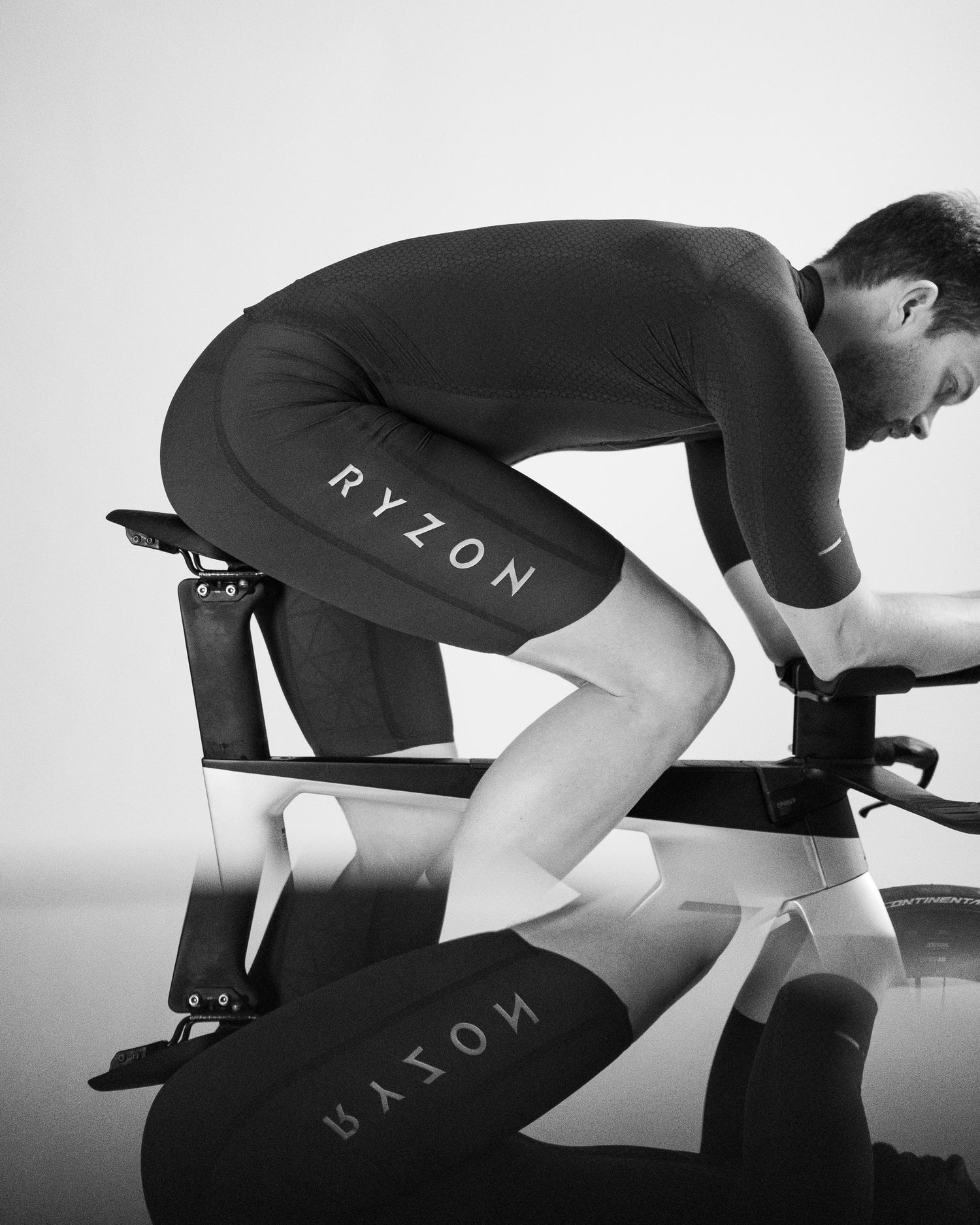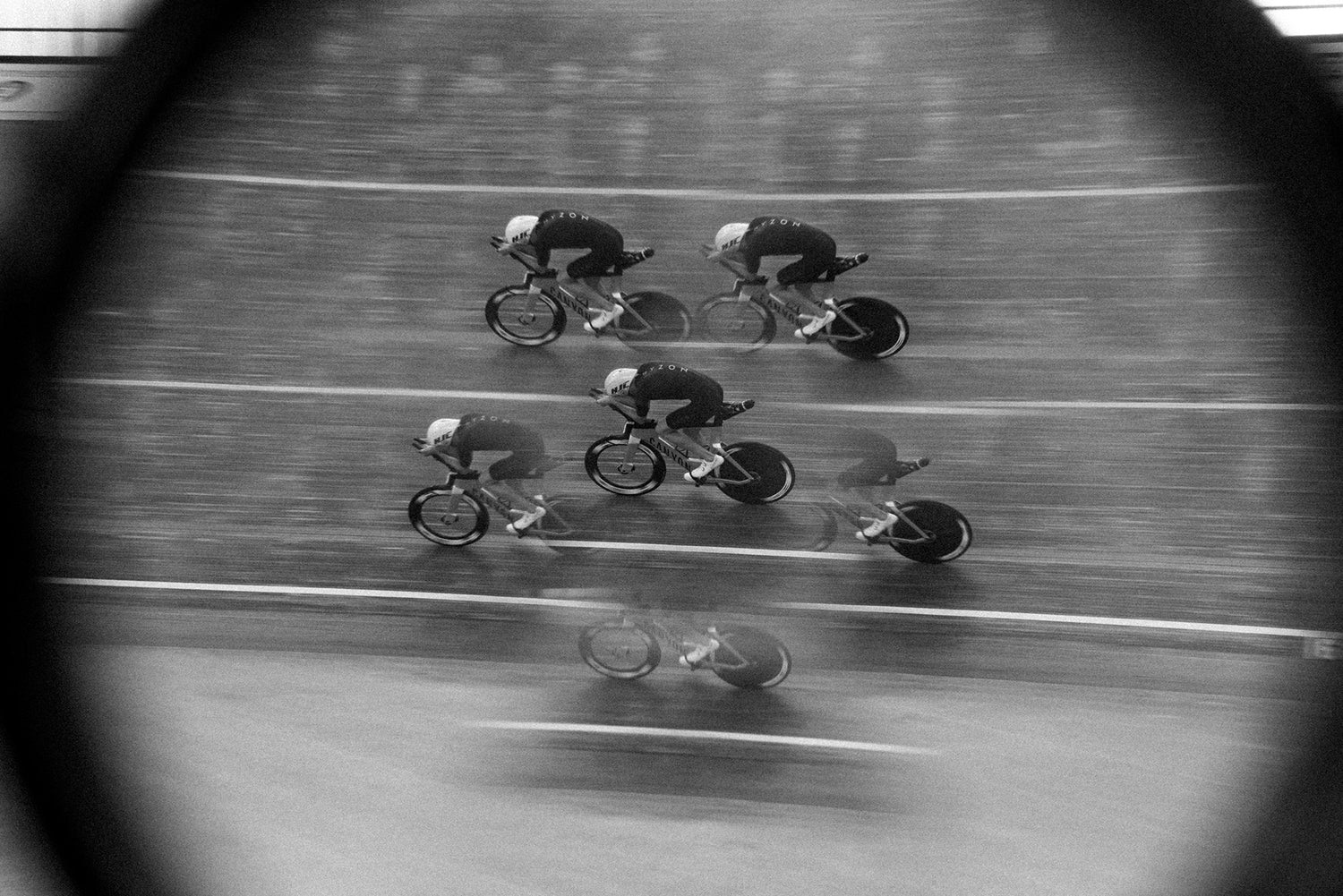Calculate triathlon times & better assess your performance
How good am I actually?
With our interactive triathlon time calculator, you can find out where you stand—whether you're a beginner or an ambitious athlete. Find out how fast you are and calculate your potential for your next race.
Why is a triathlon time calculator useful:
- Ideal race assessment: Helps with planning and tactics.
- More self-confidence: Gives a feeling of control and preparation.
- Simple & fast: Little effort for your self-assessment.
Triathlon speed calculator – how it works
1. First, select your distance or specify the routes for which you want your times to be calculated:
- Long distance (3.8km swimming, 180km cycling and 42.195km running)
- Middle distance (1.9 km swimming, 90 km cycling and 21 km running)
- Olympic distance (1.5 km swimming, 40 km cycling and 10 km running)
- Individually
2. Enter your planned times for each discipline – including the transition times between swimming, cycling and running.
3. You will then automatically receive your times for swimming - cycling - running without transition as well as your total time.
| Total time | |
|---|---|
| Swim split (without transition) | |
| Bike split (without transition) | |
| Run split (without transition) |
What triathlon distances are there?
There are various triathlon distances, which differ primarily in the distances covered for swimming, cycling, and running. The most common distances are:
| Distances | To swim | Ride a bike | Run |
|---|---|---|---|
| sprint | 500m | 20 km | 5 km |
| Olympic | 1.5 km | 40 km | 10 km |
| Middle distance | 1.9 km | 90 km | 21 km |
| Long distance | 3.8 km | 180 km | 42 km |
Triathlon rules according to DTU (German Triathlon Union)
The triathlon rules of the German Triathlon Union (DTU) are set out in the official sports regulations (SpO) . These contain all important guidelines regarding competition procedures, equipment, and conduct – and are regularly updated.
Here are some important and basic rules (as of April 2025):
General principles:
- Fairness: The highest principle is sporting fairness.
- Compliance with the Road Traffic Act: The road traffic regulations generally apply (drive on the right, overtake on the left).
- Dangerous behavior: Will be punished as a violation of the rules.
- Follow instructions: The instructions of the competition management and judges must always be followed.
- Environmental protection: Disposing of objects outside of the designated areas is prohibited.
- No outside help: Accepting outside help is prohibited.
To swim:
- No aids: Swimming without aids (fins, paddles, etc.). Goggles are permitted.
- Wetsuit: Its use depends on the temperature and is regulated by the SpO2 standard (minimum and maximum temperatures for different distances and age groups). The maximum thickness is 5 mm.
- Swimming cap: Often mandatory, provided by the organizer.
Ride a bike:
- Helmet requirement: From picking up the bike until leaving it in the transition zone, an undamaged helmet with a closed chin strap must be worn.
- Bike condition: The bike must be roadworthy.
- Start number: Must be worn clearly visible at the back.
- Sitting position: Mandatory to three contact points (saddle, handlebars, pedals).
- Drafting is prohibited: In most races, drafting is prohibited (12-meter zone, overtaking is limited to 25 seconds). Exceptions are races where drafting is permitted.
- Handlebar extensions: Permitted when drafting is prohibited, prohibited when drafting is permitted (depending on the type of race). Tube ends must be sealed.
- Clothing: At least a one-piece suit or pants and top.
Run:
- Start number: Must be worn clearly visible at the front.
- Clothing: At least a triathlon one-piece suit or shorts and top (no shirtless running).
- Helmet: May not be taken onto the running course.
- No aids: sticks etc. are not permitted.
- Shoes: Spikes are prohibited. Specific rules regarding sole thickness (max. 40mm) apply according to international athletics regulations.
- Transition zone:
- Helmet: Must be closed before picking up the bike and may only be opened after the bike has been parked.
- Getting on and off: Getting on and off the bike is only permitted outside the marked transition zone.
- Pushing the bike: The bike must be pushed in the transition zone.
Time penalties:
Violations of the rules may result in time penalties (blue card) or disqualifications (red card). The length of time penalties varies depending on the distance.
Equipment:
The equipment must comply with the rules (e.g. no unauthorized additions to the wetsuit).
A notice:
This summary is not exhaustive. The current and comprehensive sports regulations of the German Triathlon Union (DTU) are the binding basis for all triathlon rules in Germany.
Read the sports regulations carefully before participating in a competition.
Important: Different special rules may apply to certain competitions, leagues, or age groups . These can be found in the respective competition announcement or league regulations .
Where can I register for triathlons?
There are numerous events and organizers in Germany. Here are some ideas for where you can find triathlon competitions.
- DTU event calendar: For Germany, the official event calendar of the German Triathlon Union (DTU) is a great option. Here you'll find many competitions filtered by date, location, and distance. The corresponding links take you directly to the organizer's registration page.
- Regional associations: The websites of regional triathlon associations often have their own event calendars with regional competitions.
- Triathlon magazines and websites: Triathlon magazines and websites often publish event calendars and registration information.
- Friends and training groups: Talk to other triathletes in your area. They often have recommendations and know which races are available and where to register. Maybe you can even compete together.

Do you want to be well equipped for your triathlon?
Here you can find our products:

Discover more articles related to the topic:
